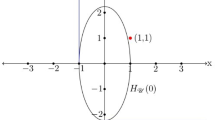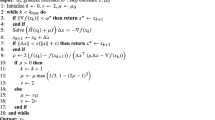Abstract
In this paper we consider not necessarily symmetric co-positive as well as semi-monotoneQ-matrices and give a set of sufficient conditions for such matrices to beR 0-matrices. We give several examples to show the sharpness of our results. Construction of these examples is based on the following elementary proposition: IfA is a square matrix of ordern whose first two rows are identical and bothA 11 andA 22 areQ-matrices whereA ii stands for the principal submatrix ofA obtained by deleting rowi and columni fromA, thenA is aQ-matrix.
Similar content being viewed by others
References
M. Aganagic and R.W. Cottle, “A note onQ-matrix,”Mathematical Programming 16 (1979) 374–377.
R.W. Cottle, “CompletelyQ-matrices,”Mathematical Programming 19 (1980) 347–351.
R.W. Cottle, J.S. Pang and R.E. Stone,The Linear Complementarity Problem (Academic Press, New York, 1992).
M.S. Gowda, “OnQ-matrices,”Mathematical Programming 49 (1990) 139–141.
M.W. Jeter and W.C. Pye, “Some properties ofQ-matrices,”Linear Algebra and its Applications 57 (1984) 169–180.
M.W. Jeter and W.C. Pye, “Some remarks on co-positiveQ-matrices and on a conjecture on Pang,”Industrial Mathematics 35 (1985) 75–80.
M.W. Jeter and W.C. Pye, “An example of a nonregular semi-monotoneQ-matrix,”Mathematical Programming 44 (1989) 351–356.
I. Kaplanasky, “A contribution to Von Neumann's theory of games,”Annals of Mathematics 46 (1945) 474–479.
S.R. Mohan, T. Parthasarathy and R. Sridhar, “\(\bar N\)-matrices and the classQ,” in: B. Dutta, D. Mookherjee, T. Parthasarathy, T.E.S. Raghavan, D. Ray and S.H. Tijs, eds.,Proceedings of the New Delhi Game Theory Conference, Lecture Notes in Economics and Mathematical Systems No. 389 (Springer, Berlin, 1992) 24–34.
G.S.R. Murthy, T. Parthasarathy and G. Ravindran, “A co-positiveQ-matrix which is notR 0,”Mathematical Programming 61 (1993) 131–135.
K.G. Murthy, “On the number of solutions to the complementary problem and spanning properties of complementary cones,”Linear Algebra and its Applications 5 (1972) 65–108.
G. Owen,Game Theory (Academic Press, New York, 1982).
J.S. Pang, “OnQ-matrices,”Mathematical Programming 17 (1979) 243–247.
T. Parthasarathy and G. Ravindran, “The Jacobian matrix, global univalence and completely mixed games,”Mathematics of Operations Research 11 (1986) 663–671.
Author information
Authors and Affiliations
Additional information
Dedicated to our colleague and friend B. Ramachandran on his sixtieth birthday.
Corresponding author.
Rights and permissions
About this article
Cite this article
Murthy, G.S.R., Parthasarathy, T. & Ravindran, G. On co-positive, semi-monotoneQ-matrices. Mathematical Programming 68, 187–203 (1995). https://doi.org/10.1007/BF01585764
Received:
Revised:
Issue Date:
DOI: https://doi.org/10.1007/BF01585764




